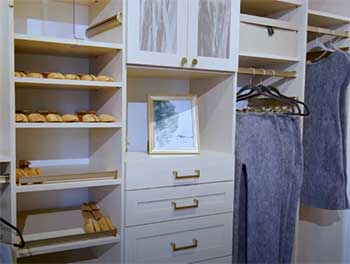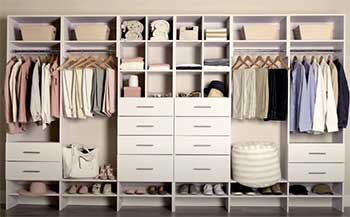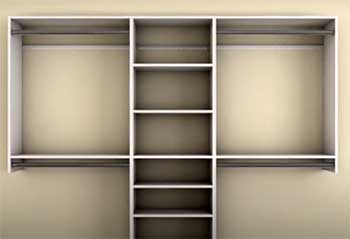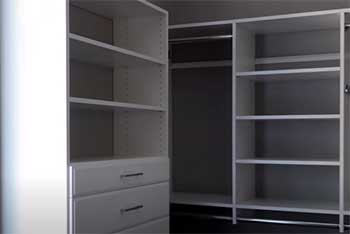As you plan your dream closet or replace worn-out storage space, EasyClosets and modular closet systems likely top your options list. Both boost organization and style, but lives differ greatly. EasyClosets excel for affordability and simplicity while modular closets emphasize strength and customization.
Choosing correctly means assessing your personal priorities, home layout, renovation budget, and intended longevity in the space. Renters need different solutions than growing families in forever homes.
Storage sufficient for two adults requires distinct configurations versus housing a family of five. With an abundance of choices, it helps to have an in-depth guide examining the EasyClosets versus modular contrast covering all considerations.
I’ll analyze the critical differences in materials, durability, customization, installation, pricing tiers, aesthetic potential, best use cases, and more between these closet storage frontrunners. Let’s first cover the general advantages and disadvantages before looking closer at what builds set them apart.
A Brief Comparison Table
| Feature | EasyClosets | Modular Closets |
| Materials | Particle board or MDF with laminate panels | Solid wood, aluminum, steel, premium composites |
| Durability | Low to moderate, laminates protect core but dent over time | Very high, lifetime guarantee on materials |
| Customization | Preset sizes, limited layout options | Fully bespoke sizing and designs |
| Installation | DIY or hire contractors for complex builds | Professional install required |
| Lead Times | Ships within 2 weeks | 8-12 weeks typical |
| Cost | $100s, affordable storage systems | $1000s+, premium customized builds |
| Visual Appeal | Simple, contemporary, fade into backgrounds | Luxurious furnishings, standout focal points |
| Best Uses | Guest rooms, kids closets, small spaces | Master suites, walk-ins, entertainment centers |
EasyClosets Quick Pros and Cons
Pros

- Budget-friendly pricing
- Ease of DIY installation
- Contemporary laminate finishes
- Fully reconfigurable
Cons
- Durability issues over time
- Flimsy feel without reinforcement
- Limited layout offerings
- Professional installation recommended for walk-ins
Modular Closet Quick Pros and Cons
Pros
- Ultimate customization
- High-end luxury materials
- Perfectly sized for space
- Lifetime durability
Cons
- Premium pricing
- Professional installation required
- Changes require full disassembly
- Long lead times
Beyond these quick comparisons, you need to dig into the composition, component quality, sizing methodology, accessories, and labor model to determine if EasyCloset practicality or modular customization matches your scenario best.
EasyCloset Materials And Why They Matter
EasyCloset leans into a budget mindset, using affordable materials with laminate veneers to mimic styles found in premium modular designs at a fraction of the price. Construction methods also focus on rapid assembly, skipping unnecessary steps that don’t directly enable faster completion times.
But these shortcuts come at the cost of long-term sturdiness, viable accessories, and flawless finishes. EasyCloset buyers trade away permanence for affordability. Understanding the core build composition clarifies realistic expectations before purchase.
- Particle Board Core

The inner structural base of EasyClosets starts with particle board or medium density fiberboard (MDF).
Particle board forms by combining wood shavings, sawdust, or chips with synthetic resin binders then pressing into sheet form.
The random shaping and orientation of particles limits strength compared to solid cut wood.
MDF offers more consistent density and weight using softwood fibers bound with adhesives. But MDF lacks much capacity to hold screws or nails without crumbling. Both particle board and MDF soak up ambient humidity, easily succumb to wear patterns in heavily trafficked areas.
Yes, they retail at rock bottom pricing. Yet inherent material weakness causes particle board and MDF limitations over decades of use. Carefully research finishing choices to offset core vulnerabilities.
- Water-Resistant Laminate Veneers
Recognizing particle board problems withhandling humidity and contact damage, EasyCloset adds strong protective veneers. High-pressure laminates utilize resin-saturated paper sheets layered under high heat and pressure. The thick melamine layers and solid edging strips resist moisture, stains, impact, scratches and wear from leverage or movement.
Laminate sheet options range from solid colors to near photographic prints mimicking wood grains, stone textures, concrete looks, and beyond. Even metal laminates like brushed nickel, oil-rubbed bronze, and antique patina copper let EasyCloset match high-end bathroom or kitchen styles at a bargain price point.
- Structural Reinforcement Points
Installing a stack of laminated MDF or particle boards alone risks imminent collapse – the weight and pressure can easily pull apart individual boxes without proper internal stiffening. EasyCloset resolves this issue by including steel T braces, panel connectors, and corner gussets with each system.
The wire/metal accent pieces slide into slots on the composite boards. As you lock panels together and anchor to the wall studs, these braces transfer and distribute weight stresses. It prevents swaying, distortion, or detachment where units join while boosting the total load capacity.
Reinforced EasyClosets withstand the needs of most single-family homes. But walk-in designs spanning entire room lengths or storage walls above 8 feet tall sometimes outpace capacities requiring posts set from floor to ceiling or along the ceiling for complete peace of mind around structural integrity relative to the total contents weight.
- Melamine Edges Hide Particle Board Core
EasyCloset boxes utilize thick melamine sheets edged with complementary laminate strips. The raw particle board edges sport fragile surfaces and uneven cuts prone to crumbling when screws tighten down into edges not perfectly straight. Edging tackles both aesthetic and functional concerns.
For example, tan particle board with a white high-pressure laminate sheet would contrast poorly without an edging transition. The extra lining hides the darker core while distributing pressure more evenly across fastening points.
It also allows matching laminates to conceal points where boxes connect together, aided by internal corner brackets and braces.
Modular Closet Material Advantages
Contrasting the affordability play of EasyClosets, modular designs leverage higher quality materials designed to endure decades of use while achieving luxury status looks. From rich hardwoods to sleek metal components and top-grade finishing options, modular closets match dream kitchen or luxury car precision.
- Solid Hardwood Cores
Premium modular closets rely on all-wood construction. Designers select solid oak, maple. hickory, cherry or other hardwood species meeting structural needs and client style preferences.
Precision joins with mortise and tenon joints or dovetails transfers weight loads safely while maintaining alignment despite building shifts or season changes.
Crafting storage units from solid cuts rather than glued composites creates durable builds capable of handling thousands of pounds without concern. Modular closets leverage the innate strength and beauty of natural wood grains rather than faking surface appearances. Expect handsome aging and character marks as years pass.
- Aircraft-Grade Aluminum and Steel
Metal plays a huge role within modular closets even when focusing on wood-forward aesthetics. Expert designers assess weight loads and span distances, using structural aluminum or steel to mitigate risks.
You might note aluminum tracks guiding doors or separating pull-out cabinets and drawers. Steel rods offer durable hanging points and enable height adjustability not workable in strictly wood frameworks.
The metals utilized clear industrial testing benchmarks for kitchen use supporting cabinets full of dinnerware. With weight capacities 10X or beyond what even expansive modular closets require, the structure will long outlast shelves, rods, and interiors needing replacement down the road.
- Premium Exotic Finishes
EasyCloset laminates expand finish offerings, but modular closets take surface veneers into luxury territory with exotic hardwoods, designer composites, and natural stones. Appearance choices like wide-plank teak, weathered driftwood mixes, bamboo, walnut, and shoreline agate stone elevate storage to spa-like atmospheres.
Even the steel and aluminum modular frameworks accept designer finishes including powder coats, physical vapor deposition, and brushed patinas.
Just like a luxury vehicle interior, clients customize finishes surrounding their clothing, accessories purses, shoes, and daily life essentials used when dressing. Expect perfect color coordination with existing décor as well.
Size and Layout Customization Capabilities
Beyond the core material differences between EasyCloset and modular storage systems, sizing and layout personalization also drastically diverge. EasyCloset relies on predetermined dimensions with limited arrangements based on budget-driven manufacturing.
Modular designs offer fully bespoke solutions tailored specifically around your available space and ideal configurations even including decorative elements that support personal style.
- EasyCloset Sizes

Given the composite panel construction, EasyClosets only produce certain widths like 12”, 16”, 18”, 24”, and 30”.
Height options hit typical increments like 72”, 80”, and 84”. This reduces SKUs and production costs by maximizing use of standard material sheet sizes.
But the incremental sizing fails to solve challenging layout quirks or combine multiple areas into a single build.
On customization, the best EasyCloset option relies on its online planning tool allowing clients to outline room dimensions, input openings or protrusions like pipes and vents, and trace angled walls or ceilings. This provides expert recommendations selecting optimal pre-designed kits meeting your basic space parameters and storage requirements.
Results remain rectangular designs emphasizing neatly segmented shelves, rods, shoe racks, and other accessories precisely arranged based on algorithms.
EasyCloset customization exists more in how you accessorize a default box than actually tailoring fundamental footprint or flow. It works well for purely rectilinear spaces without much architectural character.
- Modular Closet Shape-Shifting
In opposition to square-box EasyCloset limitations, modular customization starts with meticulous on-site measurements by the installing contractors. Laser-assisted tools map every inch, even unique details like ceiling pitches, dormers, bay windows, architectural columns and lighting placements. This scanning creates intricate 3D models.
Personalized design software allows clients to virtually build dream closet layouts within their unique spaces. Walk around the digital renderings, adjust heights, depths, divisions and more all from tablet-based apps. Change finishes or features until settling on ideal storage visions.
Finished plans integrate with home automation systems allowing remote monitoring and lighting control. You even receive realistic 3D prints of the final model for last minute tweaks before cutting manufacturing. Installers follow bespoke assembly guides unique to every job site situation.
Modular designs adapt to the most challenging layouts – angled corners, restricted pathways around infrastructure, converting raw rooms into closets, and maximizing negative spaces unused by traditional shelving. Expect perfect alignment with surrounding walls and built-in elements.
Installation Process Comparison
Modular designs counteract layout limitations by embracing on-site customization during professional full-service installation. EasyClosets instead maximize DIY assembly methods using snap-in components needing just household tools for most single-closet projects.
More intricate builds like storage walls or extensive walk-ins often require hiring installers given the planning complexities and physical demands.
- Easy DIY EasyCloset Installs
Assembling EasyClosets ranks among the simplest upgrade projects within any home. All components pack tightly and ship on a single palette. After unpacking, layout everything right on the floor within your closet. Match the pre-drilled panel holes and press pieces together by hand along integrated brackets and guides.
With panels assembled horizontally, stand up the full unit and slide into position. Use a level to keep surfaces flat and wood/concrete screws (included) to anchor through the laminate back into wall studs for lateral and gravity support.
Finish by adding shelves, rods, shoe racks and other accessories as you desire across built-in adjustment slots. For walk-ins, utilize L-posts at corners or room edges to prevent swaying based on total depth and weight loads.
With reasonable DIY skills, properly sized EasyClosets only require an afternoon for full installation. It feels similar to assembling flat pack furniture, just for your entire closet! Those less handy may still complete builds, just slower. And hiring pros remains an option if the work volume overwhelms.
- Full-Service Modular Closet Installs
Given heavy solid wood and luxury material builds shipped in multiple sections, advanced home skills fall short of smoothly installing modular closets. Significant projects require contracting regional installers for full-room builds. Sourcing qualified experts protects home finishes and creates structural integrity meeting building codes.
Following meticulous measurement sessions and extensive client design reviews, companies ship disassembled components and hardware to sites. Crews reconstruct frames securing to wall and ceiling studs before aligning trims and panels.
Multiple workdays ensure reasonable pace without cutting corners. Expect perfection matching plans without patches, visible joints, corners gaps, or uneven surfaces across even the most substantial builds.
Pricing models typically charge by linear foot based on project scope and finish gradations. Hidden costs can emerge around working structural reinforcements, drywall repair, or electrical and lighting needs into decades-old construction.
Still the precision results justify costs that would easily exceed DIY skill for most homeowners. Consider contractor installs mandatory to receive lasting quality and design continuity.
Aesthetic Potential Between Systems
EasyCloset and modular options clearly differentiate on installation complexity, customization latitude, and base material quality tiers. Another key separation emerges in the overall aesthetic results achievable. EasyClosets reliance on veneer laminates and limited sizes curb stylistic ambitions.
Modular solutions offer nearly limitless configurations plus indulgent finishes befitting luxury master suites.
- EasyCloset Visual Appeal
Reviewing EasyCloset finished products across customer photos and showroom displays reveals sharply angled shelves and hanging rods flanked by neutral colored laminate boxes in white, light grey and wood tones. Accessories add interest through drawers, shoe cubbies, and specialty racks mixed within blank canvas walls.
You’ll achieve clean, contemporary appearances on a reasonable budget. But designs lack character without finish variation or architectural detail. Form follows function in pursuit of maximizing storage capacity over style.
EasyClosets fade into the background supporting clothes and necessities rather than commanding attention with dynamic displays emphasizing your fashion or personality.
- Modular Closets as Artistic Statements
Alternatively, modular closets stand proudly as room centerpieces with compelling textures and attractive lighting themes. Shimmering glass doors enclosing artisan woodgrain shelving makes you wish closets included windows to provide views into luxury chambers from adjoining rooms.
Walk-in wardrobes mix display cabinets, drawers, hanging rods, shoe cubbies, jewelry cases, and vanities alongside lighting scenes supporting functionality. Unique storage solutions emerge by evaluating ideal access patterns and daily usage needs during the consultation process.
Life accessories integrate into builds instead of appearing slapped onto bland boxes as an afterthought.
There’s no hiding these closets away as utilitarian spaces. They live functionally and visually at the heart of bedrooms and bathrooms. As the costs imply, modular closets cross firmly into furniture territory with heirloom craftsmanship and artisanal detail. Storage rooms transform into experiences curated specifically for you.
Use Case Recommendations Between Solutions
Declaring EasyClosets or modular designs an outright “winner” oversimplifies the realistic considerations weighing on most buyers. EasyClosets bring organization to everyday households through frugal use of limited space.
Modular designs unveil dream walk-in visions through premium materials and custom-tuned storage. Typical homes likely benefit from incorporating both solutions. Let’s examine ideal use cases to guide choices room by room.
EasyClosets Best Scenarios

- Kid & guest bedrooms – Affordable EasyClosets with cheerful laminates keep clothes contained no matter how messy inhabitants get. Reconfigure as kids grow or adults visit.
- Small closets – Rectangular EasyClosets maximize neat storage in cramped existing footprints like apartments or older homes with tiny closets
- Laundry rooms – Durable EasyCloset cabinets and wall units corral laundry supplies, gear and seasonal goods. Add rods for air drying beyond machines.
- Garages – Use moisture-resistant laminate EasyClosets to organize tools, sporting goods, workshops, and storage overflow no longer fitting inside homes.
- Offices – Mimic built-ins with EasyClosets holding files/paperwork, office supplies, and hide electronics. Add desks or seating against office wall units.
Modular Closets Best Scenarios
- Master bedrooms – Luxurious customized modular closets serve as stylish daily backends adjoining master suites. Design impressively around windows, sloped ceilings and tight layouts.
- Walk-ins – Dream closets leverage high-end modular mix and match components designed specifically for weird room dimensions and ideal access flow patterns.
- Entertainment centers – Conceal home theater components within floor-to-ceiling modular cabinets featuring adjustable shelving, glass covers, and wire conduits.
- Entryways – Welcome guests with gorgeous built-in modular systems storing seasonal accessories, keys, bags and coats. Include benches or hampers.
- Kitchen pantry – Maximize awkward angled spaces off kitchens with custom-fit pull-out modular cabinets on casters offering easy accessibility for daily cooking and meal prep.
Frequently Asked Questions (FAQ)
For additional details on materials, installation, pricing, and configurations for EasyClosets and modular closets, check out these common questions:
EasyClosets utilize composite wood substrates like MDF or particle board covered in high-pressure laminate sheets for protection and aesthetics. Metal braces provide reinforcement between the panels.
Modular closets are constructed from plywood, hardwood boards, extruded metal, steel studs, acrylic, ABS plastic, polyresin panels, or composites. These provide durable, moisture-resistant material options.
DIY EasyCloset installation only requires about 1-3 hours for reach-ins or 5-8 hours for more expansive walk-in designs. Lay out components on the floor, slide together, stand up the unit, level it, and anchor to the wall. Add shelves, rods, and accessories as desired.
Installing modular closets requires professional expertise for precise on-site measuring, off-site construction, transporting materials, properly anchoring the components, and perfect aesthetic alignment. Small reach-ins may require 1-2 full work days while large custom walk-ins can take 5-7 work days depending on complexity.
Final Recommendation
Combining the insights around materials, customization, installation, aesthetics, and use cases makes the best solution clear for many homeowners.
- Young families on a strict budget optimize with EasyCloset systems as temporary solutions in kids rooms and secondary closets
- Homeowners and long-term renters should strongly consider EasyCloset walk-ins as an intermediate upgrade until ready to invest into permanent modular custom builds.
- Luxury homes, master suites, and aging-in-place scenarios gain huge quality of life benefits from modular closet investments.
Evaluate your unique home architecture, ages of inhabitants, planned occupancy duration, renovation budgets and style preferences to decide if convenience and affordability or enduring craftsmanship suits better. EasyClosets deliver temporarily to occupy basic storage needs.
Modular designs inspire daily as beautiful showpieces displaying your life. Budget for higher costs, longer lead times and installation mess, but the lasting rewards elevate living considerably.
Both closet systems eliminate messy floors and overflowing spaces. EasyClosets just tidy up affordably and rapidly. Modular closets craft transcendent order optimized specifically around you.
Use this thorough comparison guide to make savvy choices room by room striking the right balance to meet practical organization and individual style needs in your home.

